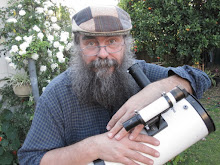Tuesday, June 14, 2011
Supernova sn2011dh in M51 is brightening!
 Supernova sn2011dh in M51 imaged with the GRAS-05 instrument. Left image 4 June, right image 10 June. Both are 120 sec exposures using the luminance filter. The 10 June supernova image is visibly brighter than the June 4 image (click to embiggen).
Supernova sn2011dh in M51 imaged with the GRAS-05 instrument. Left image 4 June, right image 10 June. Both are 120 sec exposures using the luminance filter. The 10 June supernova image is visibly brighter than the June 4 image (click to embiggen).Most of you following this blog, or astronomy news in general, will be aware of the “bright” supernova in the Whirlpool Galaxy (M51).
I’ve been following the supernova over the past week (and encouraging others who are doing this to submit their images for crowd sourcing). After the first two images I tried my hand at photometry, to estimate the brightness of the supernova.
 My estimated supernova magnitudes, with 95% confidence intervals.
My estimated supernova magnitudes, with 95% confidence intervals.My first two images were from 4 June and 6 June (due to this thing called weather). I used spot densities from the calibrated (but otherwise untouched) FITS files derived using ImageJ. I used the densities from the supernova and 6 reference stars spanning the range of M13 to M15.1.
To my surprise, the supernova hadn't faded according to my data, but actually brightened. Given the accuracy of my measurements though, it could have just not have dimmed much.
So when I looked at my next image from the 8th, it looked as bright as the nearby reference star, and my photometry confirmed this.
 Then the image of the 10th the supernova was definitely brighter than the reference star (see image above). My photometry showed it to be M12.7.
Then the image of the 10th the supernova was definitely brighter than the reference star (see image above). My photometry showed it to be M12.7.So how good was my photometry. I didn't have many reference stars between M14 and M13 (mostly because when I designated my reference stars I was expecting the supernova to dim, and partly because they
 were what I had magnitudes for) and I'm using spot densities rather than areas as is standard.
were what I had magnitudes for) and I'm using spot densities rather than areas as is standard.I was only moderately confident in the accuracy of the magnitudes. So I checked the sn2011dh webpage, and to my surprise found that my magnitudes fitted very closely with the magnitudes reported by others. The supernova's magnitude has now plateaued around M 12.8 (which is pretty typical of Type II-P supernova, although how typical the upward bump is I don't know).
This is definitely a supernova worth continued following (now I find I should have been doing exposures with BVR filters). Again I urge people to submit their images (details here). Calibrated but otherwise unmodifed FITS images are best, but all images are welcome. Of course, with the Moon almsot full imaging will have to take a break for a while, but when we have some less Moon-haunted skies it will be interesting to see what this supernova will be doing.
Labels: Global Rent-a-Scope, supernova
Comments:
<< Home
Excellent work! you are very lucky to have good sky conditions long enough for this kind of measurements. I got a picture a few days ago but didn't got the chance to follow up, because of the weather.
http://jeudy.wordpress.com/2011/06/07/%C2%A1supernova-en-m51-capturada-desde-cartago/
http://jeudy.wordpress.com/2011/06/07/%C2%A1supernova-en-m51-capturada-desde-cartago/
There is also a start class article on Wikipedia about SN 2011dh. It seems to be acting like a Type IIb event.
Jeudy: Nice shots, pity about the weather.
Kevin: Ta! I completely missed the IIb possibility, but the second hump is consistent with that.
Kevin: Ta! I completely missed the IIb possibility, but the second hump is consistent with that.
Well done! I was out last night looking for it, sure not to find it in my 10" reflector, and instead there it was, incredibly the brightest star around that area. I had first seen it on the 8th at approximately magnitude 14, so I didn't expect it to be visible now. What a treat, and thanks for confirming what I saw.
Antonino Carnevali.
Post a Comment
Antonino Carnevali.
<< Home





 Click to read about or order
Click to read about or order Click to read about or order
Click to read about or order Click to read about or order
Click to read about or order Click to read about or order
Click to read about or order




